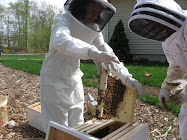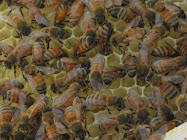A gigantic THANK YOU to my friend Diane who came over to help me make some maneuvers with my hives that I had been uncomfortable with because of my inexperience.
The first order of business was to go into my "right" hive to dig down and get the queen cage that had dropped to the bottom of the hive. Diane and I were both secretly worried she might have died if she was still stuck in her cage, screen side down.
Before going in, we puffed a little smoke into the entrance. I was certainly over smoking. Diane just said one or two small puffs was sufficient. She uses a little natural twine and pieces of smoker fuel (looks like compacted, recycled cardboard). Oddly enough, this seemed a lot more effective than my pine needles had been -- even when I had a nice stream of smoke going. Hmmmm?
First I took off the top box enclosing the sugar water. Here is my sugar water 'pickle jar' flipped upside down with several holes punched into the metal top with a small nail. This is just set off to the side (right side up) with any bees sipping up the sugar water left on the lid. They pretty much just stay put.

This is how the top of the inner cover looks when you remove the jar of sugar water. Lots of bees are at the top sipping away.

At this point, we puffed a little smoke towards these bees and in the hole of the inner cover. When you remove these small pieces of wood that prop up the feeder, just set them aside with the bees on them. They may stay or fly off -- this keeps them calmer than brushing them off.

Incidentally, a friend of mine from my bee class, Sarah, took these pictures. Thank you Sarah! I haven't been relaxed enough to snap photos yet while working my bees. One day . . .

See that large bee in the middle of the photograph with the large eyes? This is a 'boy bee' -- a drone. They were actually moving around more than I was imagining they would be. I thought they'd just sit there -- waiting for service. But they actually move around and at least appear to be busy.

I'm not certain if this is my left hive or my right hive, but when we opened the right hive up, even though I'd removed a hand-sized piece of burr comb just the day before, the bees had already created another large piece that was attached to the top edge of the wooden frame.

After puffing a little smoke in between the frames, Diane removed one of the outside frames and set it by the entrance. She removed one of the center frames and set it aside (leaned up against something, so it's still standing up) with the bees busy on the hive. For the most part, they just keep doing what they were doing. A few start flying around like they are wondering "Okay, who ran off with frame #4? Which way did it go? Which way did it go?" But we didn't have any bees bouncing off our veil in anger. Diane reached down and grabbed the queen cage sitting on the bottom of the hive, screen side down. THE QUEEN HAD GOTTEN OUT OF HER CAGE! Wonderful!!! Somewhere in that hive, was my queen. Diane immediately got the other frame and double checked to see if the queen wasn't on the frame sitting outside the hive. Nope. Not there.
Meanwhile, we removed the burr comb. Diane demonstrated. Gently use your hive tool to scrape the burr comb off. Keep your fingers ready to hold onto it so that it doesn't drop to the bottom of the hive. (It's okay if it does, it's just one more thing to do.) Smoke the burr comb to get the bees to move off, then give it one firm shake. Most of the bees should be off. Maybe one more shake or two. Set it aside. (Diane is on the right, I'm on the left)

I pulled the frame out and Diane scraped the burr comb off.

Here is a close up of the frame. Still no queen.

The life cycle of the worker honey bee is 6 weeks. So, in six week's time my hive will all be the same 'breed' as my queen and her drone mates (they only make one 'mating flight' in their lifetime) which is a Goldline Carnolian Honey Bee. The worker and drone bees from my package are Italian Bees. Sadly, the markings of my Goldline Carnolian Honey Bees won't be quite as distinctive. I love these gals. Aren't they adorable in their distinctive stripes?

Finally, on the next frame we lifted we located my queen. As you can see, she has a green dot on her. For the new bee keepers, our queens were painted so that we can be sure to identify her while we learn. As you can see, she is much longer than the other bees and her 'butt' is much bigger.

Isn't that great? My queen, busy doing her thing. See how the bees around her create a circular shape? This is her "court" the bees who have the job to care for the queen. Neat, eh? Look at the bee on the lower left hand side of this shot. You can see her 'pollen baskets' are packed with yellow pollen. Sooo cool.

On to the 'left' hive. This was the hive I successfully released the queen into, but the burr comb was extensive between two frames and I didn't know how to handle it, especially since I had just released my queen into that area! Before I forget . . . Diane told us that you can tell if your hive is having a bad day and is a bit feisty at this point. If you look at the bees on the top of the inner cover and see their pointy butts sticking up in the air -- they aren't feeling very patient. Good day to wait for the next day or two. Close her back up and go on your way. When we were closing up the first hive (the right one) Diane showed us there were a few bees on the top of the inner cover who had their butts up. They look very pointy. Rather than curving down towards the ground, they stick up into the air. They were just demonstrating that they were ready for us to go. We did.

Here are the bees poking out of the top of the inner cover opening. As you can see, there is even burr comb sticking out of the top.

When we opened up the hive we could see how much burr comb was there. See it all? If you don't remove these pieces of burr comb it will lock up your hive and you wont be able to freely remove each individual frame to check on the progress, status, health of your hive.
Can you see how I was a little intimidated? I thought this comb was actually attached to the wax foundation in the frames, but actually at this point, it wasn't. It's still just attached to the top of the wood on the frame.

See how they are just staying busy with their work?

Initially we thought the two frames were burr combed together. I started to pry them apart, but then Diane realized they weren't actually attached. So, she just gradually moved them apart with her gloved hands.


Diane pulled the frame with the largest piece of burr comb out. She gently pried it off the frame.

And placed it on the top of the frames. We gave it a little smoke to get most of the bees off. Then she gave it a good shake. At this point there were a lot of bees that had been displaced so they were flying around, but not coming at us at all. But there was a lot of zipping around and buzzing.

I removed this small piece of comb left of the frame by using my hive tool. There was another large piece of burr comb sitting on the bottom of the hive that had fallen when we'd removed the inner cover. Diane reached in and pulled it out. Smoked it. Shook it.

As we removed the comb, we kept an eye out for the queen that I'd released the day before. We hadn't run into her. After the burr comb job was done we examined each one again and finally we found her. Her court bees had groomed most of the green paint off her back, so she was harder to spot. Yea! I was starting to doubt that I'd released her into the hive!
The next time I will go into my hive is in one week to refill the sugar water jars and check and see that the queen as started to lay eggs. One week to relax.
I do have one bone to pick with my bees though. Although they are visiting many of my bushes and tress on the right hand side of my house, they are not pollenating and visiting the trees, bushes, flowers, fruits and vegetables on the left of my house . . . the side with my garden! But they are visiting my neighbors! Sure, my neighbors are going to have a banner year growing their vegetables, but not me. Hmph. I guess sooner or later they will find all of the goodies waiting for them on the other side of my house . . . I'm waiting. Not so patiently. :)
































8 comments:
What courage! Not just for going into the hives but for undertaking such a big project. We want to to make mead this year but we'll purchase our honey. Will you try that too?
I've never tasted it. Is it yummy? One of our teachers at the bee school is very into making mead. I have NO idea what's involved. You never know with me . . . :)
That's what Joel (my "hive buddy") wants to do with any honey he gets.
What is mead? You go girl! What about moving 1 or both of your hives to the other side of the house?? Just a thought, what does a non bee girl know? So how much honey is in the burr comb, do you have to remove it for any other reason than what U said so the hives don't freeze up? This is so cool. :)
Apparently Mead is like wine or beer, but it's not. It's made out of honey & water and fermented with yeast. Sometimes it's flavored. Sure would be fun to try. Why not. http://en.wikipedia.org/wiki/Mead wikipedia tells about it.
There isn't any honey in the burr comb -- yet. Mostly just sugar water and a little nectar and pollen in a few places. It really is important to be able to 'get into' and check on your frames. The burr comb locks everything up.
Bee's know exactly where their home is. If you move it -- even several feet, you have to bring your hive a few miles away for several days -- like a week -- before you move it to the new location in your yard. (this is where friends and family would come in) If you had 100 hives next to each other, they would know the exact spot where to go back home to. But the good news is, I saw several of my honey bees on the 'other' side of my yard today!! finally! :)
There are a few commercial meads available at package (liquor) stores which might be a good way to sample it and see it you like it. We have tried it and some are really delicious.
I'll have to check it out! :)
Thank you for the terrific pics! I am taking a page from you book and having a bee-friend come to my house and help me get my queen out of her cage! The snow has melted and the fruit trees are blooming. So, they will have some food and hopefully, the queen will stay put in once I get her out of that cage ;)
Post a Comment